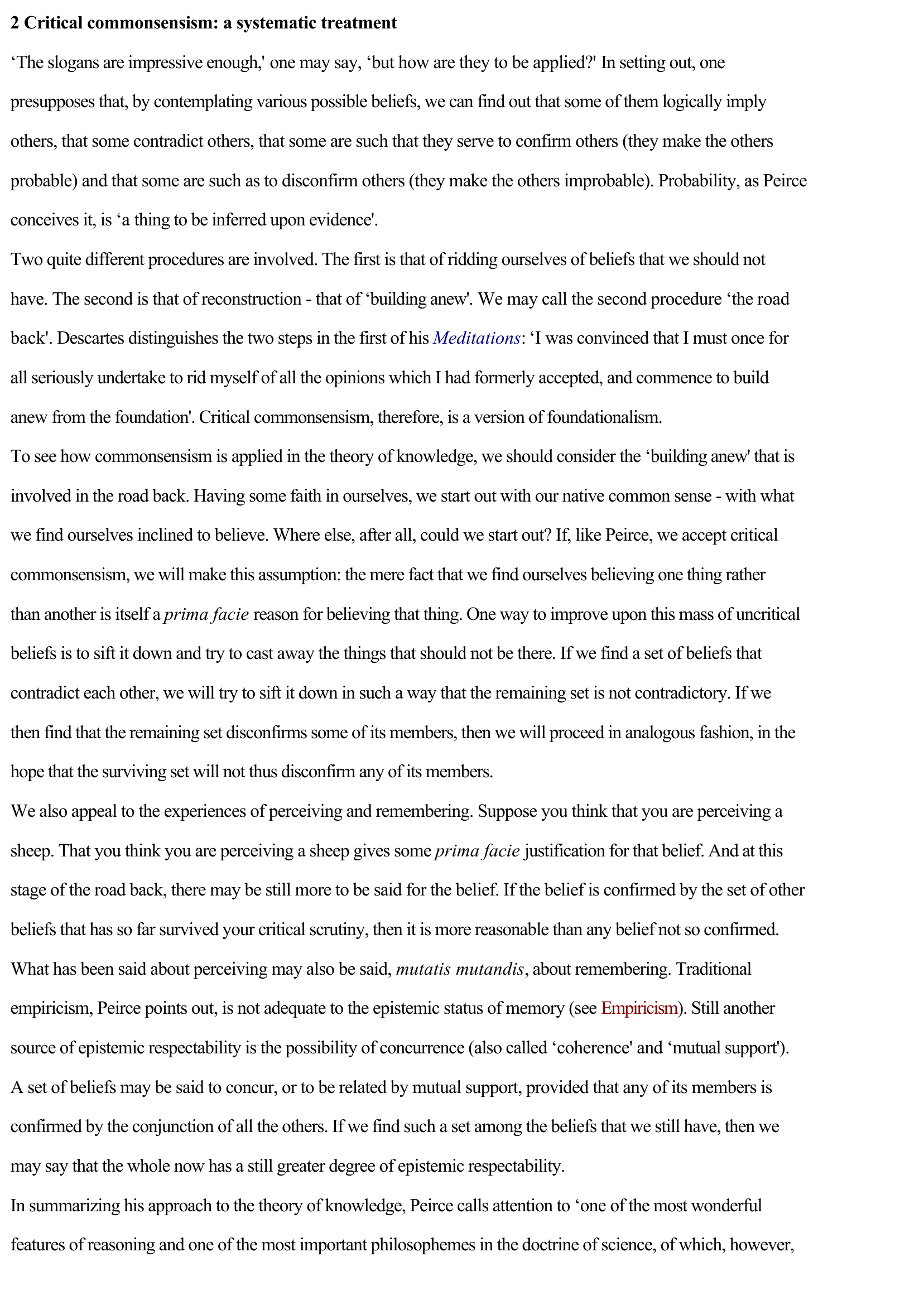Commonsensism
Publié le 22/02/2012

Extrait du document
«
2 Critical commonsensism: a systematic treatment
‘The slogans are impressive enough, ' one may say, ‘but how are they to be applied? ' In setting out, one
presupposes that, by contemplating various possible beliefs, we can find out that some of them logically imply
others, that some contradict others, that some are such that they serve to confirm others (they make the others
probable) and that some are such as to disconfirm others (they make the others improbable).
Probability, as Peirce
conceives it, is ‘a thing to be inferred upon evidence' .
Two quite different procedures are involved.
The first is that of ridding ourselves of beliefs that we should not
have.
The second is that of reconstruction - that of ‘building anew' .
We may call the second procedure ‘the road
back' .
Descartes distinguishes the two steps in the first of his Meditations : ‘I was convinced that I must once for
all seriously undertake to rid myself of all the opinions which I had formerly accepted, and commence to build
anew from the foundation' .
Critical commonsensism, therefore, is a version of foundationalism.
To see how commonsensism is applied in the theory of knowledge, we should consider the ‘building anew' that is
involved in the road back.
Having some faith in ourselves, we start out with our native common sense - with what
we find ourselves inclined to believe.
Where else, after all, could we start out? If, like Peirce, we accept critical
commonsensism, we will make this assumption: the mere fact that we find ourselves believing one thing rather
than another is itself a prima facie reason for believing that thing.
One way to improve upon this mass of uncritical
beliefs is to sift it down and try to cast away the things that should not be there.
If we find a set of beliefs that
contradict each other, we will try to sift it down in such a way that the remaining set is not contradictory.
If we
then find that the remaining set disconfirms some of its members, then we will proceed in analogous fashion, in the
hope that the surviving set will not thus disconfirm any of its members.
We also appeal to the experiences of perceiving and remembering.
Suppose you think that you are perceiving a
sheep.
That you think you are perceiving a sheep gives some prima facie justification for that belief.
And at this
stage of the road back, there may be still more to be said for the belief.
If the belief is confirmed by the set of other
beliefs that has so far survived your critical scrutiny, then it is more reasonable than any belief not so confirmed.
What has been said about perceiving may also be said, mutatis mutandis , about remembering.
Traditional
empiricism, Peirce points out, is not adequate to the epistemic status of memory (see Empiricism ).
Still another
source of epistemic respectability is the possibility of concurrence (also called ‘coherence' and ‘mutual support' ).
A set of beliefs may be said to concur, or to be related by mutual support, provided that any of its members is
confirmed by the conjunction of all the others.
If we find such a set among the beliefs that we still have, then we
may say that the whole now has a still greater degree of epistemic respectability.
In summarizing his approach to the theory of knowledge, Peirce calls attention to ‘one of the most wonderful
features of reasoning and one of the most important philosophemes in the doctrine of science, of which, however,.
»
↓↓↓ APERÇU DU DOCUMENT ↓↓↓









